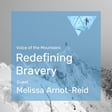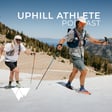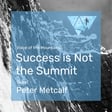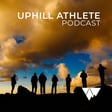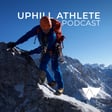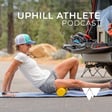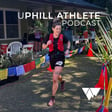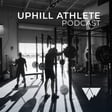Become a Creator today!Start creating today - Share your story with the world!
Start for free
00:00:00
00:00:01

Talking Speed and Form for Endurance Athletes
In this episode, Scott Johnston and Sam Naney discuss the subject of speed, an often overlooked element in endurance sports.
Transcript
Resources for Mountain Sports
00:00:01
Speaker
Welcome to the Uphill Athlete Podcast. These programs are just one of several free services we provide to disseminate information about training for mountain sports. If you like what you hear and want more, please check out our website, uphillathlete.com, where you'll find many articles and our extensive video library on all aspects of training for and accomplishing a variety of mountain goals. You'll also find our forum, where you can ask questions of our experts and the community at large.
00:00:30
Speaker
Our email is coach at uphillathlete.com and we'd love to hear from you.
Hosts Introduction
00:00:37
Speaker
Welcome to another episode of the Uphill Athlete podcast. I'm your host Scott Johnston, co-founder of Uphill Athlete and with me today is my longtime favorite athlete and now coach at Uphill athletes, Sam Naney. Welcome Sam, thanks for joining us. Yep, good to be here again Scott.
Is Speed Important in Ultra-Endurance?
00:00:55
Speaker
Well, today, Sam and I are going to talk about something that I think is near and dear to our hearts from our ski racing backgrounds. And that is the speed, the subject of speed. And I think that that's something that's often overlooked in ultra endurance type events, where athletes are not moving anywhere near their top speed. And so people tend to think that speed is not a very necessary
00:01:22
Speaker
component to train, but I think we can offer some insights into that as how a person can actually improve their performance with a little bit of speed training.
Coaching Philosophy on Speed and Power
00:01:34
Speaker
Well, thanks, Sam. Let's start by defining... Well, actually, I want to start with a little saying that we have actually out in our gym, and that is... On yellowing paper. Yeah, on yellowing paper. And it says, speed kills those that don't have it. And that was a little ditty that I got from a track coach at one point. It makes a lot of sense.
00:01:58
Speaker
But we're going to do first kind of a deep dive into some of the theory behind speed training. And I'll start off with a few points that I want to make and then let Sam take it from there.
00:02:15
Speaker
Speed, of course, is the ability to move quickly. And what we know about speed is that it is primarily a neurologic training effect as compared to endurance, which is primarily a metabolic training effect. And you need to be strong in order to be fast, and you need to be powerful in order to be fast. And in fact, I think of speed being the
00:02:45
Speaker
pinnacle of a pyramid that is supported at the level right below it by power and at the base level by strength. And that you'll never be fast if you're weak. And so it's important that you, that's one of the ways we can help people develop speed is first of all, just making it a bit stronger.
Building Strength and Power
00:03:04
Speaker
And then also once they're strong enough, we can introduce some power into their movements, power of course,
00:03:13
Speaker
strength being really just the force you can generate with your muscles and power being the rate of that force generation. I think it's a very short jump from power to speed because you can understand that somebody who can generate a lot of force very quickly is probably going to be pretty fast. Usain Bolt being a perfect example.
00:03:39
Speaker
So what are your thoughts when you begin to like formulate ideas or how do you, what, how does your, you know, what is your brain telling you about speed, how do you kind of
00:03:51
Speaker
Have you created a framework in your head about how you think about speed? Yeah. When I think about it and certainly when I talk to athletes about training speed, if there's any question about why it might be relevant to say an ultra runner or a mountaineer, then I'll tell them exactly what you just said. I think having an ability to move quickly and quickly obviously is relative to whatever your chosen objective is.
00:04:22
Speaker
Ideally, you want to have speed, and we'll talk about this later, and ultimate ability to move faster than is required for the majority of your sport. It's good to have that reserve, and we'll get to that topic. But starting with that idea that speed is important, regardless of your pursuit, and then go on and try to describe speed as a component of strength. So if a strong muscle
00:04:51
Speaker
is one that can move really effectively through its range of motion and it can fire really quickly. As you say, you ideally can take that muscle that has that good range that can fire quickly and then you want to create that power component so that it can fire quickly many times and exert a high force.
00:05:15
Speaker
I think helping to couch the idea of speed as a form of strength can then make it easier to think about how to create workouts around building speed, recognizing that it is indeed a strength component that you're trying to hone.
00:05:33
Speaker
Yeah. And it's that power thing, I think, where I find the most interesting component of speed is in the power. It's that rate of force production. And, you know, your experience as a sprinter in cross-duty skiing, you know, we worked on that a lot. We spent a lot of time developing the ability to, you know, apply force very quickly and then many times over in order to help you to accelerate you.
00:06:01
Speaker
And I think that something that will be interesting for the folks in our audience, which are primarily people who do events that last many hours and sometimes even longer, is the notion that we're not talking about sprint speed in this talk today. I mean, it's important to understand that, yeah, 100 meter runner, that is pure speed. That's really all they're worried about. There's no endurance component to that.
00:06:30
Speaker
But we have a more complicated situation, you know, in the sports that we work with because we have that neuromuscular component that needs to be trained. But on the other side, we have to also train that metabolic effect, the endurance component in those same muscle cells.
00:06:48
Speaker
So because our events aren't 10 seconds long, it could be 10 hours very easily. And so I think it's, so what we're going to talk a little bit about here is what we, a term that we use is called event specific speed. And that's the speed that you need to be, you're generally going to be
00:07:06
Speaker
doing or needing to move at in the event that you're training for. And so in the kind of sports that we're talking about, that could be everything from a vertical kilometer race, which is something around an hour or less, all the way to 100 miles or a multi-day event. Climbing expedition. Climbing expedition, all that, yeah.
00:07:34
Speaker
And so it's important to kind of identify what that, what your event specific speed is. If you're training for something that's an hour or less, that's going to have, that's going to have a very different speed component of training than something that's multi-hour. Would you agree?
Tailoring Speed Training to Events
00:07:50
Speaker
Yeah. Yeah. And I think this is where, you know, we talk about this a lot in, in thinking about the sports that we often work with, you know, as, as objectives for people.
00:08:00
Speaker
they're not as easily quantified as, say, a track runner or a half marathon or a marathon road runner. In those sports, there tends to be a much firmer sort of gradation of target speeds you're trying to hit. So you want to run a three-hour marathon, you have a pretty good idea there of what your per-mile time needs to be.
00:08:28
Speaker
And so you look and say, okay, my goal is a three-hour marathon and currently I can run a 312. And so this is how much improvement I need to see in my average mile time in order to get there.
00:08:40
Speaker
And once you've established those quantities, then you can work backward in building out training that, that gradually eats that, you know, that speed out of your per mile time. But if you're looking at something like a hundred mile trail race, you've got periods of time during that race where you're, you know, you're running down a for service road and maybe you're clipping seven minutes, seven and a half minute miles. And then other times you're climbing up a steep barely trail on, on, on a, on a steep mountain.
00:09:09
Speaker
and you're going 25 minute mile at best. So how to define what is the speed you're hoping to achieve there is really important. And I think that's where we talk a lot about creating the economy of the muscles to be able to do work in the best possible way so that they can be most adaptable to those changing circumstances in a given event or a given objective.
00:09:37
Speaker
Yeah, and I think it makes sense then to, because almost all these, I would say, all the events that we generally deal with have a great deal of variety of the speed, like you just mentioned, because of the terrain variations.
00:09:53
Speaker
As a consequence that you might, especially in something like a long distance running race, where you'll be running some and walking some in that race, you need to be training speed in both those modalities. You can't just rely on running speed to make you faster at uphill hiking. And so you kind of have to have a.
00:10:18
Speaker
an approach that targets both those types of modalities. For mountaineering, it's going to be more basically putting one foot in front of the other, hiking steeply uphill, but that also has its own component of speed. I certainly do hear a lot of emails from people saying, well, I can go forever. I just can't go very fast. And so that's somebody who's lacking speed.
00:10:43
Speaker
They're not strong enough, probably, or powerful enough to move faster. I hear this often from mountaineers. They're not very experienced just getting started. How can I improve my rate of climb? How can I get faster?
00:11:02
Speaker
First, you got to get stronger, especially in mountaineering because you're probably carrying a heavy pack. And then we need to develop more power and you need to do just like the ultra runner, you need to be doing your speed training in a very event specific way.
00:11:19
Speaker
So, you know, as a wild example that wouldn't work at all, be to try to do your speed work on a bicycle when you're training for mountaineering. Yeah. Your legs could move really fast, but it doesn't look anything like your event. And so this is, I think in these, whenever it comes to intensity, whether it's speed or aerobic intensity, and we're going to talk a bit about that too here in a while, I always focus on
00:11:44
Speaker
event-specific movements in those. The higher the intensity, the more this needs to look like the event you're training for. I think that's a really good takeaway for people too, is to just understand that you could do downhill running and become really fast at it, but that's not going to probably help you in your vertical K.
00:12:05
Speaker
Right, yeah. You're going to gain some biomechanical benefit from doing that. So you're creating turnover, maybe running downhill could help you in terms of getting you into a position that you're trying to achieve. But yeah, you need to turn that specificity lens toward actually going uphill. And I think one thing you just mentioned that I think is really important when we'll hear people say, for instance,
00:12:34
Speaker
I'm signed up for this climb and I'm told I need to be able to climb 1,500 feet per hour with a 40-pound pack. I've just spent the last three weeks putting on a 40-pound pack and trying to climb uphill as fast as I can in order to reach that. What we would then say to that person is like, well, if you don't yet have the speed to do 1,500 feet per hour,
00:13:01
Speaker
Without a 40-pound pack, you're not doing yourself any service by putting on the pack and trying to achieve it in that most specific form. We need to step back from that and get you to be able to be moving at that speed first without the weight and then build your economy on top of that to be able to do it with the weight because you're not going to be able to achieve that.
What is Periodization in Training?
00:13:24
Speaker
There's too much of a load to overcome.
00:13:26
Speaker
I think that's a really good point. Thanks for bringing that up, Sam. I think that that's something that we're...
00:13:33
Speaker
as I think most people who listen to our podcast and read our books or spend some time on the website understand that we follow the idea of periodizing training. And that's a big word and it's a kind of a difficult subject some kind of people do. And there's some controversy about periodization, but we have found over many, many years that
00:13:56
Speaker
periodizing. In other words, in different periods of a person's training, they'll be focusing on different qualities that they're trying to improve. And so, like Sam was just saying, we would train that person that wants to climb 1500 feet an hour by having them hike uphill without a pack until they could comfortably do 1500 feet an hour,
00:14:18
Speaker
And on the other end of the physiological spectrum, we would probably have them in the gym doing heavy box step ups at the same time. So in this, what we would call the base period, we would be focusing on, you know, on one end of the physiological spectrum, the metabolic effect that's needed to move you up that hill at 15.
00:14:39
Speaker
100 feet an hour. And the very opposite end of the physiological spectrum would be training the neurologic effect, which is your ability to take a big step upward with a heavy pack on your back. And we like to train these, what we call fundamental qualities in the base period in separate workouts.
00:15:00
Speaker
And then eventually, once we feel that the strength is high enough and the metabolic quality is there, we bring those together. And then that's the event-specific speed endurance training that we'd be doing, because we're bringing the endurance end of things together with the strength end of things. Yeah, and we see this, I think,
00:15:24
Speaker
I try to describe that to athletes as a pyramid. At the base of your pyramid, at the foundational level of your training, you have these individual components. As you've described, you have your aerobic capacity, you have your foundational strength that maybe is being developed in a gym doing box step ups and adding weight to your box step ups. Then you have this neuromuscular speed component where
00:15:50
Speaker
you're creating the biomechanics and the neuromuscular coordination to move quickly. And then as those individual components get stronger, you can create workouts that start to combine them.
00:16:05
Speaker
with the idea that the tip of that pyramid is basically your objective. It's being able to do 1,500 feet per hour with a 40-pound pack. But I think when we think about mistakes, as we've described with this one, a mistake would be to try to train your ability to do 1,500 feet an hour with a 40-pound pack by going out and doing that thing. I think similarly, what we
00:16:29
Speaker
see across the board with endurance sport is that folks and I think we're both, you know, have fallen victim to this mentality and in our own training at times, we'll try to achieve improvements in speed by starting at too global of a level, right? So instead of trying to work on
00:16:52
Speaker
For instance, if we think about Nordic skiing, trying to develop the biomechanics and the really effective technique moving quickly over a 10 or 15 second period so that they can have that high turnover, they might go and do sets of four-minute intervals. So now they're trying to ski fast, but they're trying to do it for longer and they're trying to do it that has a high aerobic demand. They're just not going to be able to achieve that ultimate speed corner that they want because there are too many other loads being piled on them at that time.
00:17:22
Speaker
Yeah, I think that's a really relevant point that we should spend a little time on that. Excuse me. What we've been talking about in this periodized approach where we have these fundamental qualities that we're trying to elevate those fundamental qualities. And once those qualities are elevated to a sufficient level, and that's judgment, and of course also has to do with how much time do you have before your event.
00:17:50
Speaker
But once those, those qualities are elevated, then we can bring them into these, a workout that combines speed and endurance. But the, the tendency of a lot of folks, we hear this, you know, I'm sure we hear it several times a week where people contact us and say, yeah, I'm just doing all these weighted hikes and that sort of thing. And, but we find out they're aerobically deficient.
00:18:15
Speaker
So they're lacking probably the most important fundamental quality for these kind of long distance, long duration events is that aerobic base. They're lacking that, but they're going right to the sexy stuff. Right. The most specific global type of workout. Yeah. And the problem with that is that global, that mixed workout that has all these qualities brought together into one workout,
00:18:42
Speaker
that thing is never going to be fully effective if any one of those qualities, those fundamental qualities are lacking. So if your aerobic capacity sucks or you're not very strong, I'm using two really simple cases here where you're not very powerful, then doing a speed endurance workout
00:19:02
Speaker
you know, hiking uphill as hard as you can with a 40-pound pack is not going to give you the benefits that would if you spent the time to elevate those fundamental qualities before you did that. Now, with that said, I just mentioned the fact that
00:19:19
Speaker
This is highly dependent on how much time you have between where you are today and where you need to be on a certain date, climbing that 1500 feet an hour. And at some point, you will need to be doing that kind of mixed speed endurance work, where you put the heavy pack on, you hike uphill hard.
00:19:39
Speaker
Because if you don't do that, your body's not going to know what it's like when you actually get there. Exactly. You're not going to be well prepared for the climb. So we have people come to us and say, I've got six or eight weeks before a reineer going on this climb on reineer. And we will do what we can to elevate some of those fundamental qualities. But eight weeks isn't enough time to really move the needle very much in either the strength end or the aerobic end.
00:20:06
Speaker
So we just, you know, it's counter to our philosophy, but we just have to say, okay, you know, here are six weeks out, we better start doing some heavy weighted climbs with you. Otherwise you're going to get to Rainier and you're, like you said, your body's really not going to know what hit it. Well, and I think it's, it's, you know, we, we talk often about the mindset of an endurance athlete in this, you know, the sort of type A personality that it draws. And I think this, this is yet another one of those examples of why
00:20:34
Speaker
folks like us and many of the people that we work with are drawn to these sports.
00:20:38
Speaker
is that they require just a significant level of just toughing it out. And you have grit and tenacity. And so what unfortunately comes of that mentality or perception of what the event's going to be is this notion that if you train in that way, if you're training reflects that sort of boy, just working hard, gritting your teeth, going, then that in turn is going to be
00:21:06
Speaker
highest contribution to your ultimate outcome. But in reality, you know, just knowing what it's like to work hard is usually not going to be enough if you don't have other pieces in place. And I think one of the things that's really gratifying for an athlete and certainly for a coach working with someone is to have gone through these steps that we're talking about and particularly
00:21:33
Speaker
building up speed and someone's ability to move fast over a distance from that foundational level and then have them get to their objective and thinking about something like Rainier as an example, and having them come back and be like, oh my gosh, I felt so in control the whole time. I never felt extended beyond myself. Yeah, there were parts of each day where I felt like I was working, but I was never at the ragged end.
00:22:02
Speaker
And that, I think that was a real realization for me in ski racing.
Is Toughness Enough for Endurance Sports?
00:22:08
Speaker
When we had sort of cracked that, cracked that code in terms of how we approached the training and built those qualities all up is that, you know, it could be a really challenging race and, you know, high quality field racing, you know, at the, at the high end of speed, but felt in control, you know, there wasn't
00:22:27
Speaker
It was certainly not the case where as soon as the gun went off, you were just, you know, tongue dragging 10 feet behind you and just working hard as possible. It was, you know, you were sort of in this optimal place of matching the ability to move at a certain rate with what your body's capacity could do. I think that that point you started this with is really important that it's
00:22:52
Speaker
The people who are attracted to this, we know these sports take a lot of grip. You know, you need to be tough. You need to be able to suffer. But some people, I think, just think that's all there is to it. And that those, I mean, I use this, I think I've used this example in one of our earlier talks, Sam, I think about the marathon. You know, the marathon is an event that is competed at one's aerobic threshold. And so when we look at these incredible Kenyan runners, you know, running, you know, 202 marathons,
00:23:21
Speaker
They're not running harder than you and I would be running. They're just running a whole hell of a lot faster than you and I are rerunning. And I think that that's the mistake a lot of people make sometimes is they just think, oh, those mountaineers or 100 milers, people that do these 100 milers, they're just, you know, you have to be incredibly tough, which you're going to suffer a lot out there. But that can't be the only tool you bring to the party. It's got to be just, you know,
00:23:50
Speaker
It's there. You're going to have to draw on it. But if you don't have some fundamental speed that you've been working on, and I'll talk about with Sam, what we did to help him develop speed and the economy of moving fast. And we'll talk about what economy means in a minute.
00:24:12
Speaker
was we were doing these on roller skis, this essentially like a track sprinter would do. We were doing 100 meter repeats on roller skis and we were using electric timing wands. And what we found very quickly was that if Sam put out 100% effort
00:24:37
Speaker
it was generally slower than if he dialed it back and felt like he was really pushing it more like 90 to 95% effort. And I think that was due to that relaxation. It really helped you. And we did, I don't know how many hours of that kind of training we did. I don't know, but it was a lot, but it paid off. It did. And it's interesting because as you're mentioning that, I remember when we first started with that kind of work, so we ended up doing a lot of that in the skate tech
00:25:07
Speaker
on roller skis, and I remember before a lot of those abilities, before we really kind of honed those abilities, earlier durations of that we'd be doing striding on the track on roller skis, and I remember feeling so tight and restricted because I hadn't yet developed that relaxation at speed, but was trying to move really fast for these 100 to 200 meter sections
00:25:33
Speaker
striding on classic roller skis and just the whole body being under tension. So I probably wasn't going as fast as I ultimately could have if I just dialed one half notch back. But more than that, I remember just some absolutely epic crashes because it'd be so tight. And then, you know, you stick one pole in between your legs. And I remember doing just this outrageous Superman flying across and just getting it all skinned up in road rash, which, you know, thinking back on it,
00:26:02
Speaker
Again, think about the significant cost that was being put upon my muscles to be under that amount of tension trying to go fast versus those later iterations where we figured out.
00:26:18
Speaker
If I just tried a little less hard with the skating, I could achieve the same result, or maybe even faster. And I think that, again, that concept of relaxation and speed can translate to
00:26:34
Speaker
all these other things we're talking about. If you feel like you are at the ragged edge of your effort range to be hitting that 1,500 feet per hour on a climb, then not only are you working hard to achieve that, but there's just the tension that your body is under and the separate component here that we may or may not touch on that sort of psychologically or mentally that you're under to have that sort of
00:27:05
Speaker
Tension and tight focus is going to be much more costly than if you have an ultimate capacity to maybe do 2,000 feet per hour. But all that's being asked of you for that given climb that day is 1,500 feet an hour. So you're like, yeah, I'm operating at 75%. I'm great.
00:27:22
Speaker
I can keep going for hours in this way. When I think about speed and how I want to prepare my athletes for their given objective, that's my goal. I want you to be able to do this so that when you actually get to your objective, you only have to do a portion of that.
00:27:40
Speaker
You're not, you know, you're not at your ultimate extension because, and then we can have that, that buffer in between the two as, as the sort of just in case portion. Yeah. And that, that buffer is often called speed reserve.
00:27:54
Speaker
And so, I mean, as an example, I've had some pretty good ultra runners who couldn't run very fast. And so when they got to a flatter section of the course and all of a sudden the pace kicked up to six minute miles, they get dropped because they don't have any, for them, six minute miles is flat out. And whereas if you're a high level runner, maybe if your mile pace is five minutes,
00:28:21
Speaker
then when you hit, you know, six minute miles, it's going to feel relatively relaxed and easy for you. So developing a speed reserve. And so the same thing for that climber. If that climber had been climbed at 2000 feet an hour and, but yet the rate that they're really going to be required to use is only 75% of that, they're going to feel a lot more comfortable. They're going to be able to go farther with it. Um, and on kind of that, that same topic,
00:28:45
Speaker
with, I had a ski coach once when I was younger who told me this very wise thing that I struggled with at the time. He said, if you can't ski one three minute kilometer, how are you going to ski 50 of them? And at the time I was like, I was really disheartened because I was struggling to get to where I could ski a three minute kilometer. And then I thought, oh shit, he's right.
00:29:08
Speaker
how am I gonna string 50 of these things together? But that's really kind of what we're talking about here. And so you need to, you have to build the ability to move that fast first and then work on extending that for longer and longer times.
Speed Reserve in Endurance Events
00:29:25
Speaker
Now in my case, it was three minute kilometers. In your case, it was closer to a two minute kilometer in those sprints. And with the mountaineer, it's this 1500 feet an hour
00:29:38
Speaker
you know, it's an arbitrary number we're using here. That's nothing special. So don't, please don't, don't go home and write your entire training plan around that. Yeah. We're just using that arbitrarily. Um, but you need to, that's why we have, Sam was suggesting in the beginning with this Mountaineer, we would have them train without a pack to develop a speed that's required first, and then we can extend it or we can make the resistance higher by putting a pack on them. And I think that, you know,
00:30:10
Speaker
I think it can be disconcerting or not in line with an athlete's thinking initially, particularly for the mountaineer or ultra runner or a backcountry skier or whatever it is. When you think about your given objective or your sport and in your mind, I'm moving at a pretty slow rate for a long time.
00:30:34
Speaker
you know, durability and just, you know, I need to be able to manage nutrition better. I don't need to be able to run fast, but you think about what the, you know, if you have these, again, these really good biomechanics. So for the, for the runner, if you, you look at
00:30:50
Speaker
some of the greatest marathoners or you watch Usain Bolt and you see how well they run and they're running incredibly fast but they look relaxed and it looks like they're doing exactly what their body was designed to do in the most effective way and if you can imagine taking that
00:31:08
Speaker
component, the economy, the biomechanics that they have, and then if you need to dial it back to the slower speed that's required for your event, there's going to be such greater relaxation than if you're training at a limited range of motion. Think about the ultra shuffle. For instance, if we think about an ultra marathon, if
00:31:31
Speaker
If all you're doing to go out and do your training is running at this slow 10 to 12 minute mile pace for hours on end and ultra shuffle with a narrow range of motion, then you're not developing those really good biomechanics that, as you say, might be coming really handy when you have a flatter section or a downhill, or just in general, you don't have that range.
00:31:53
Speaker
the most important thing that we can train as athletes is range and having that ability to be adaptable. For the runner, we use things like hill sprints, which are really valuable, short 10 to 12 second efforts with long recovery. So you're being really dynamic, you're
00:32:15
Speaker
creating is you're applying a high amount of force through the muscles, strides during a run equally short, but same sort of thing. You're turning it over just long enough to kind of get yourself up to speed and really extend that range of the muscle before you slow down again. Those are different ways in which people can start working on these elements of speed without being concerned about really tapping deeply into an endurance base that they may be still building.
00:32:43
Speaker
Yeah, I think that exactly not going, you know, not going from no speed to trying to do mild repeats at your race, at your race pace. That's the mistake that we see often. And so the hill sprints, which I think we've talked endlessly about in our books and on the website,
00:33:04
Speaker
and we use I think I would say most of our coaches using with almost all of their all the coaches using with most of their athletes I'm sure we found them to be super effective at building uphill power because it's very it's a very powerful movement.
00:33:19
Speaker
And strides are running on a flatter terrain, which will help you with leg turnover and a more normal running type of a stride than necessarily sprinting uphill. What we do use with our hill sprints is pretty steep terrain. And that's because a lot of our events are done on steep terrain. And so we will have
00:33:49
Speaker
20% gradient, typically at even more if we can find it and have good footing at it. I think that's a great way to build leg power for athletes.
00:34:00
Speaker
I think one of the things that can be beneficial with hill sprints as well is that having the incline provides a little bit of an advantage to an athlete in terms of developing running form because you're naturally leaning into the hill when you're creating that, trying to generate that speed. It puts you into that running position that we want to try to achieve when you're running on flat terrain.
00:34:24
Speaker
sort of is a bit of a kickstart for that when you're working on improving your running form. So it has this dual advantage in terms of, because I think, again, the biomechanical component of this is so important in terms of developing speed. If you're rigid and tight and a tight range of motion, you're not going to be able to extend that speed for very long.
00:34:45
Speaker
Absolutely, yeah. And I think another point I want to make about hill sprints and another reason we use them is that they're safer than flat sprints. And sprinting is, you know, classically you hear about, you know, track sprinters with pulled hamstrings and that sort of thing. I mean, it's pretty easy to injure yourself in these really explosive, powerful movements.
00:35:06
Speaker
And we find that the impact is lower because you're running uphill. So the impact of when you land on that foot is going to be a lot lower than the impact if you're landing on flat ground with that forward foot.
00:35:21
Speaker
And so if you, so don't go right to the track and start doing 100 meter or even 50 meter sprints, that's a great way to get injured. Especially as an ultra endurance athlete, you probably don't have the strength in those connective tissues to support that level of power.
How to Build Leg Power Safely?
00:35:41
Speaker
So hill sprints can be a great way to introduce that. And then these strides that Sam was mentioning a minute ago,
00:35:48
Speaker
we tend to do those at less than full speed. I often tell the athletes I work with, accelerate up to what feels like a fun, fast speed. You feel good, you feel relaxed, it's not a sprint, and you get up there and you hang on to that speed for just a few seconds and then
00:36:06
Speaker
It's over. Slow back down, jog for at least two or three minutes and then toss another one of those things in. I think that's a very tried and true method of
00:36:20
Speaker
of training speed. In fact, I had a good friend back in many years ago who ran, he was a miler at University of Oregon under Bill Bowerman, who's the famous track coach at Oregon. And Dennis told me that they ended every single workout with strides because Bowerman felt like you needed to stay in touch. Even they'd go out and go run for five or 10 miles and come back on the way back to the
00:36:50
Speaker
locker room, they would throw in strides. And I think it's touching on that speed frequently, but not excessively. It's really an important way. So don't, your first stride workout or your first hill sprint workout, don't go out and do 20 repetitions of this stuff. First of all, you might just be crippling yourself and it's better to do it twice a week at a little lower volume than once every two weeks or so that's it. Well, and I think again,
00:37:20
Speaker
to continue extolling the benefits of strides, it's progressive. So you're starting at whatever your normal aerobic pace is. And then when you decide to begin a stride, you start accelerating. It's not as if you're sitting, you're kind of crouched down into the blocks and then explode out of there. So one, you have a bit of injury resistance there just by the nature of it being progressive. But also, I think it
00:37:48
Speaker
It kind of gives you this continuum of perception in terms of, okay, this is how I feel in terms of my running form and tension in the muscles. Everyone, I'm just running at my normal pace. Now I'm going to start accelerating.
00:38:00
Speaker
And you can be observing how you feel as you ramp up that speed to what you say, as you described, sort of that fun, fast, or 90% effort, say, and get a real feel for what that feels like. Are you particularly tight? Ideally, I'll tell people, you don't want to try to go so fast that you start getting tensed.
00:38:24
Speaker
That's the threshold that you don't want to cross, but each time you do them, you're gradually ramping up and then you're gradually coming back down.
00:38:32
Speaker
And so you can collect in a lot of information along the way about how your body's feeling, how comfortable are you running that fast? And then each time you do them, hopefully you increase that comfort and find yourself being a little bit more economical. Well, we certainly see that in practice that people, you know, over the course of several weeks become much more comfortable at speed. And it's a great, we will always use, you know, hills prints and strides.
00:39:00
Speaker
before we begin to introduce intense aerobic work. It's the typical interval workout because we're trying to build that speed and comfort at speed first and then we start adding the endurance component to it. Let's talk a bit about economy and what that means. What does that mean to you? I think about economy as a muscles or think more globally about the body's ability
00:39:27
Speaker
to do a certain degree of work with the most effective use of energy available. So a muscle's ability to fire most forcefully with the least amount of energy consumption. And then so by extension, if you're an economical runner, you can run a certain distance and be improving upon that distance and improving your economy by using less total energy to do that work.
00:39:56
Speaker
Yeah, I think that's the generally, that's the definition I think that's common is the energy cost to locomote yourself at some speed. And of course that's going to vary. One of the things we've been talking about in the last half an hour is how the faster you go, the more energy it takes to do that. Part of that is because we become more and more tense and we're not as relaxed.
00:40:24
Speaker
So we need to be training economy for us, these events that we work with.
00:40:31
Speaker
The economy needs to be in that event specific speed because there's no point in you becoming super economical at running 24 second, 200s if you are a 100 mile runner. It's a wonderful thing to have, but I don't think it's the most efficacious. It's like being able to deadlift 300 pounds when you're trying to be an ultra runner. It's fun, but you have this excess of strength. Right.
00:40:59
Speaker
Because the endurance component plays such a huge role in all of these events that we're training for, you know, I'll preface this by saying that's why we spend so much and we spend so many words and hours talking about aerobic base because that is the thing that you have to have in order to
00:41:21
Speaker
even complete, let alone do well in these longer duration events. But when you have this speed reserve, like we're talking here about, that speed reserve is relative to the event you're training for.
00:41:38
Speaker
you're going to be more economical at your event specific speed if you have a speed reserve. Like Sam has been saying, if you're tacked out at seven minute mile, then if that's your top speed, then even running at eight minute mile is going to be pretty costly for you. You're probably not going to be very economical at that speed.
00:42:01
Speaker
And so economy can have, I think of economy as having two components. One is the metabolic cost of moving yourself at a certain speed. And the other is the biomechanics of moving at that speed. And they're of course, they're not completely separable. They're one and the same because if you have crappy running form, it's going to cost you more metabolically to run at a given speed.
00:42:30
Speaker
But we find that doing this kind of speed work, whether it's hiking uphill at 3,000 feet an hour without a pack, so that when you're hiking uphill at 2,000 feet an hour, it feels totally comfortable and relaxed, or learning to run comfortably at a six minute mile pace instead of a seven minute mile pace, all of that will improve your economy when you're in your event, even if you're moving slower than that.
00:42:59
Speaker
Although I want to go back and reiterate that if you're in an event that includes a lot of walking, which most of these things do, you better get pretty good at walking fast. It's not the same as running fast. And I think one thing that bears mentioning that we were talking about before we started this recording, Sam, was that
Hiking vs Running for Efficiency
00:43:22
Speaker
walking is a lot more economical than running. And I think most ultra runners have experienced this, that at some gradient,
00:43:31
Speaker
It becomes better for you to walk than to run because you can probably walk just as fast, but at a whole lot less energy cost. Oh, yeah. Yeah. And you watch top level ultra runners or mountain runners competing, particularly in something like a vertical kilometer. And, you know, there's the power hiking, you know, whether it's.
00:43:53
Speaker
You know, an athlete might be using poles or maybe they're, you know, pressing down on their, on their thighs to, to help, you know, apply more force to the ground and keep themselves in a position where they're going up. Those are that specific technique. Um, I remember when before I was doing a tremendous amount of running and it was more ski racing, I would go out and do.
00:44:12
Speaker
do runs with Allison, who has done a lot of ultra marathons. I could run just fine uphill, but when it came time for us to do long hiking sections, she would immediately start moving away from me. It wasn't because I was tired. She just had much greater economy. Her biomechanics allowed her. She could have a nice quick cadence with her hiking.
00:44:36
Speaker
But she was putting more force down with each hiking step to be able to move faster. And I found that I would have to walk a few strides and then I'd have to run a little bit to catch up to her. And that was sort of my first light bulb moment in that respect as to how important it was to develop that, that walking wasn't
00:44:55
Speaker
So, walking or hiking in something like an ultra isn't just the absence of running. It's not just the thing that you do when you get too tired, as you say. There are times when it's really a lot more effective and more specific to the given terrain to hike really well. I've watched people and I've been passed by people who are hiking and I'm trying here to run.
00:45:18
Speaker
If you think about it from, again, an economical standpoint, when you're running, you're springing off the ground each time. So if you're trying to do that and you're fighting against gravity, that's a tremendously higher cost than keeping one foot planted at each time and not levitating your body off the ground as you go. Yeah, that vertical component of moving your center of gravity up two or three inches,
00:45:45
Speaker
that is done in running that isn't done so much in walking the vertical oscillation and walking or hiking whatever you want to call it not running is much less than in running and we were talking earlier that many of these fancy new watches will actually allow you to track your vertical oscillation and
00:46:07
Speaker
And to optimize that, you want to reduce your vertical oscillation so that you're not spending too much energy vertically going up and down. Then you can transfer that into a horizontal trajectory for yourself. But yeah, I think running and walking need to be trained. And I've worked with
00:46:31
Speaker
ultra runners who were very reluctant to train walking. They just did not want to go there. They think, oh, I've got to run, I've got to run. But when I was collaborating with Killian a lot on the new book,
00:46:46
Speaker
He told me some of his favorite workouts were, it was an interval session basically that he did where he would do two minutes at high tempo running and then two minutes of long power hiking striding. And then he would do that for an extended period, 30 minutes, 45 minutes, something like that, just to mix it up so that he could get, he was getting intensity in both modalities that way.
00:47:12
Speaker
You know, Killian's pretty fast at all this stuff already, so he doesn't need, he doesn't spend a lot of time working on pure speed. But so he, those were, that was one of those speed endurance type workouts that Sam and I were mentioning earlier. But, you know, here's perhaps one of the greatest ever, maybe not perhaps, but is the greatest ever mountain runner. And we see him mixing it up like that, just so that
00:47:37
Speaker
in a race, he can either make transitions when the terrain changes or just be really good at walking fast. Again, I think it's so valuable to think about it, again, not as walking being the absence of running, the easier thing to do when the terrain gets tough, but the more effective way to move
00:47:59
Speaker
Another example, I remember really distinctly when Mike, our friend Mike Foote came here to visit a couple of years ago and we did a Skimo interval workout. I think I had just gotten a pair of Skimo skis and I was really excited and I'm going to go do some intervals with Mike who of course was trained for world championships in Skimo at that point.
00:48:21
Speaker
I thought this would be great because I'm a Nordic skier, so I can classic ski really well. We were going to use some terrain on a steep section of Nordic Trail that, okay, this is still kind of strideable terrain. I remember how quickly he moved away from me with this kind of quick tempo cadence, very staying low to the ground and not trying to extend this long gliding stride, but just a quick turnover.
00:48:47
Speaker
And here I am trying to reach my foot out and stride and glide like I'm on a pair of Nordic Classic skis and realizing the cost that I was expending, trying to really forcefully throw my leg forward and glide was so much higher than his much more economical quick turnover where he wasn't just launching his whole body into each movement but keeping the cost low for each stride and thus moving away from me.
00:49:15
Speaker
It's another example where there might be times on a flat section of a course in a given ski mountaineering race where you do want to exert that, have longer glide and a longer stride length, but having the ability to turn it over quickly and be more economical on the steep terrain is really valuable. I thought a lot about that workout since we did it, and I think that
00:49:43
Speaker
What happens in cross country skiing is because the skis are meant to glide, if you do throw a lot of weight onto that ski, it will glide with you on it and you get a free ride out of it. But with that full length skin,
00:49:58
Speaker
You know, you can huck all that weight out onto that ski. It doesn't glide for like two inches and it stops. And so you've spent all this energy. It's then immediately absorbed by the friction of the skin and especially going uphill. And with heavier gear on your feet. Yeah, right. And obviously when you're on flatter ground, you don't have that. The friction isn't the same, isn't as great. And so you can get some glide out of racing.
The Importance of Specificity in Training
00:50:26
Speaker
mountaineering racing skis, but that was my interpretation of like, why is this not working? Which why can't we ski up these hills like cross country skiers? But I think it's just because the skis don't glide for crap. Yeah. And again, it just, for me, it filed away yet another one of those examples.
00:50:45
Speaker
of how important specificity is, that you can't take a biomechanical set of skills that you learned in something that might seem to be pretty analogous and bring it to another sport and expect it to bear the same fruits. There are certainly advantages that you can gain by being a Nordic skier and transferring over to becoming a ski mountaineering racer.
00:51:13
Speaker
your aerobic capacity is undoubtedly good, maybe your anaerobic capacity, all these other components, but you still need to learn how to skin really well. And there's a lot of components to that technique that are really important. And so I think, again, we sort of, we bring it back to this idea of speed and how the athlete can evaluate what they need to do to improve their speed. And the first thing they need to do is identify what are the specific movements that they need to be making for their objective.
00:51:41
Speaker
And from the very foundational level, whether it's, you know, doing functional strength in a gym or doing the sort of what we might call, you know, pure speed or neuromuscular type speed workouts, such as hill sprints, how to best replicate the movements that you're trying to accomplish in your ultimate goal in those foundational training workouts.
00:52:05
Speaker
Yeah, and I want to say that these hill sprints that we've talked so much about, I would say they form a pretty fundamental part of the uphill athlete.
00:52:15
Speaker
approach to training, and we find them valuable for all these mountain sports. Whether it's mountaineering, running, skiing, it doesn't really matter. Having powerful legs is going to help you move uphill a lot faster. So don't think that if you're not training for trail running, that you won't get some benefit out of hill sprints.
00:52:41
Speaker
Just be careful. Stop at the first sign of injury. Any time you're doing any sort of powerful explosive things, whether it's plyometrics in a gym, jumping up and down off a box, hills, sprints, whatever it is,
00:52:56
Speaker
don't push yourself through pain because it's pretty easy to derail your training for weeks and weeks at a time while you heal torn achilles tendon or whatever it is. So be very careful with the approach that you use to speed, especially if you're coming from a background where you haven't ever done any of this kind of work. And you're used to going out and hiking uphill at 1,500 feet an hour
00:53:25
Speaker
which isn't very powerful for most people. Yeah, and I think that segues well into what I think is really important to talk about with these sorts of workouts is being cognizant of, as you say, how to warm up really well, and then also the recovery, not only the recovery from the workout itself, but recovery within the workout.
Recovery and Mindset in Speed Workouts
00:53:47
Speaker
So, you know, when we think about, if you're, for instance, we'll take hill sprints, we've been talking a lot about that. If you're trying to exert the, or get the highest speed possible out of each repeat, say your workout has you doing 10 reps of a 10 to 12 second hill.
00:54:07
Speaker
That's your work. Those are the hill sprints. And so you go through an elaborate warmup. You start with some very easy running, and then maybe you do some gentle skips or strides up the hill, gradually warming your body up to what will eventually be really explosive movements.
00:54:22
Speaker
Again, so those muscles are warm through that full range of motion. And then when you do say your first sprint and you mark that spot where you finished, it's really important to allow for a full recovery. And I recommend athletes are doing somewhere two to three minutes.
00:54:42
Speaker
You have a 10 second sprint and then I want you to take two to three minutes and walk back down the hill and maybe you do a little stretching and maybe these are great to do with other people because you can feel that time chewing the fat while you're waiting at the bottom. Then you do it again. The reason for that is that it's not an aerobic workout. You're not trying to
00:55:02
Speaker
You know, get your heart rate up and then keep it up for the duration of the workout the way you might. And, you know, another sort of aerobic intensity session. The whole point is to.
00:55:13
Speaker
get the target muscles to fire as quickly as possible with the highest amount of force that you can exert out of them and then allow them to recover as much as they need until they can do that same thing or better again. What we have to think about when we're training that foundational level of speed is that you're probably asking the muscles to do something that is at
00:55:36
Speaker
the upper bound of what they're comfortable with. So they're not very resilient to that at that point. So if you truncate that recovery and you try to sort of skip through it, like, ah, you know, I walk back down after the first couple, I feel fine. I'm not even breathing hard. I'm gonna go again. The muscles aren't going to have replenished the fuel that they're using to do that work. And so each time you're gonna end up going slower. And if you go, you know,
00:56:04
Speaker
Again, specificity. If you train moving slow, then that's what the muscles are going to know. They're not going to know how to go fast. They're going to know that, okay, when I do this and I exert this amount of force, I'm only going this fast.
00:56:17
Speaker
Yeah, it's very easy for athletes that don't have much formal training and speed to turn their speed workouts into endurance workouts. Because the endurance athlete thinks standing around is a complete waste of time.
00:56:34
Speaker
in an aerobic base building or an endurance workout, yeah, it isn't the most effective thing. If you're doing hard intervals, of course, you need a recovery. But generally, the recovery isn't as important in the workout for these workouts that are trying to develop aerobic capacity. But with this, where you're trying to develop maximum power, then, as you say, the recovery is everything.
00:56:58
Speaker
because as soon as you can't reach that line you drew off the top of the hill after your first sprint, you need to either think, okay, I better take an extra minute now to see if I can do it. Even taking an extra minute, you still can't hit it. Then you say, okay, that workout's over. It did what it was intended to do. It fatigued the fibers that are your most powerful fibers that you could current, at your current level, could recruit.
00:57:25
Speaker
to use, those fibers are now fatigued. So they got the training effect they want, even though it was only 10 seconds long. And I think that is a real struggle for many endurance athletes to think, well, what good is training going 10 seconds? Right. Right. I did a cumulative total of 60, 60 or a hundred seconds worth of work. That's not very much endurance world. Yeah. Yeah. And so, and I think then what the, what the subsequent mistake that's made is and this, you know, particularly if
00:57:55
Speaker
an athlete determines that the way they're going to train speed is maybe through two or three minute long intervals with perhaps equal rest or perhaps even less, is that it just becomes a different workout. That's an endurance workout. Right. It becomes an endurance workout, but unfortunately, it may be an endurance workout that's also slow. In that, I think where we, again, we harp on this a lot, but it's
00:58:18
Speaker
It's what you see so often is that interval workouts become simply a workout to train your ability to work hard. To suffer. To suffer, yeah, to work hard but not go very fast. Yeah. And so it comes back to this idea and we've talked about it in other podcasts and Allison and I have talked about it with regard to strength is just being intentional about what you're going to do.
00:58:42
Speaker
If you decide I want to train my speed as a runner and I've heard that hill sprints are the way to do it, so approach that workout. When you go and do your hill sprints, approach it with that knowledge that my whole goal for this workout is to spend a certain amount of time going as fast as possible. As you said, if you establish your baseline with that as fast as possible speed being the mark at the top of the hill where you hit with your first hill sprint,
00:59:11
Speaker
If you can no longer achieve that mark and you keep inching backward on the hill with each subsequent rep, then again, be faithful to the goal of the workout and acknowledge I'm no longer training speed.
00:59:26
Speaker
Now I'm just training, you know, my ability to work hard and I need to pull the plug because the goal is not being met or maybe the goal wasn't that I, you know, I did four repeats and I achieved and I did that. That's great. Maybe next week I can do five or six and, you know, be, be comfortable with the idea that training is progressive and go do an aerobic workout. Yeah. Tomorrow you do get to do one of those long. Yeah. Yeah. But I think that the.
00:59:53
Speaker
I know that we worked a lot on this with, you know, in my ski coaching career and a lot with you is it's pretty easy.
01:00:02
Speaker
to be a slow, effortful athlete. In our case, we would say skier. So it was pretty easy to be slow and effortful. We were trying to make you fast and effortless. And I think that's what we're shooting for here. And that's the mistake, again, the mistake that a lot of these endurance athletes tend to make when they shift, start doing speed work is if the effort isn't
01:00:27
Speaker
If they're not getting exhausted doing it, they don't feel like they're getting any training. They must not be fast. And if you go, I'm sure there's many of them on YouTube. I remember when Usain Bolt was at his peak, his coach published quite a few of his workouts on YouTube.
01:00:46
Speaker
And it was incredible to watch how little those guys actually ran in those workouts. I mean, they might not run more than a total of 400 or 500 meters in a two-hour workout. Most of the time was spent lying on the ground stretching and stretching their calves and resting.
01:01:06
Speaker
That's really hard for endurance athletes to wrap their heads around. I remember when I was a swimmer, at quite a high level, having the sprinters would do one workout and all the distance swimmers would do another workout. We would just think those sprinters were just the laziest people in the world because
01:01:27
Speaker
You know, they get in the pool and they, you know, swim 25 meters really hard and they get out and snap the towel at each other's butts and, you know, banter back and forth. And then five minutes later do another one. They might swim 500 meters in a workout, you know, where we're swimming 5,000 meters in that same workout. And, but it's, you're training a completely different system. And I think that, you know, we want to make that, we're making that point here to people that, that you're,
01:01:53
Speaker
you have to respect the system you're trying to train. And I think you can approach it as when you're going to do your Hillscrant workout.
01:02:04
Speaker
Or, or when you're going to do it, uh, you know, again, if we think about speed train speed is a form of strength. So if you're going into the gym and doing a strength workout, you are, uh, you are, you need to think about approaching those workouts as a dedicated sprinter might do, or as a dedicated strength athlete might do. And, and as you say there, you know, it's, it's not about trying to race through all the different, all the repeats as quickly as possible, keeping your heart rate up. I mean, when you, when you watch someone like Usain Bolt run the hundred,
01:02:34
Speaker
You know, when he crosses the finish line, he doesn't collapse at the end. He's like prancing, you know, beyond, around the track and looking very relaxed. I mean, certainly it takes, it takes a tremendous degree of effort on, to a certain extent to do that work, but it's not in the way that we as ultra endurance athletes think about just complete global exhaustion. And, and so I think putting yourself a bit in that mindset when you approach these sort of speed workouts can be really helpful.
01:03:03
Speaker
in terms of doing them effectively, instead of bringing your 50-miler mindset to a hill sprint workout and just trying to push through, regardless of how fast or slow you might be moving. Another mistake that I've seen frequently made is that people, they're going to think, well, that hill sprint workout, I'm not running very much. I'm sure maybe I do a 15 or 20-minute warm-up, and then I do this warm-up on the hill, like you're talking about,
01:03:31
Speaker
You know, skipping or bounding, you know, low, medium intensity. And then I do the sprints and then it's over. And where if you're used to doing three hour runs, you're going to go, well, this doesn't feel like much. The mistake I've seen with people is they throw this hill sprint workout in the middle of a three hour workout. And so they're trying to mix speed and endurance in the same workout. So you could potentially do that, but do the speed first.
01:04:00
Speaker
I don't think you're going to run for an hour and a half and then do your heels prints and then run for another hour after that. Because your muscles are going to be blunted. You're going to dull yourself. And this is another copy that I want to talk to you about sometime in the future. Sam is the concept of fatigue and what that means. But the main thing that
01:04:20
Speaker
we know and we have you and I and our coaches have learned over many years is that you have to do the quality before you do the quantity because there is a neuromuscular, excuse me, there's a neurologic component to fatigue that will set in, even if you go out and run easily for an hour and a half,
01:04:45
Speaker
As you said, you're going to be dulled. Your nervous system is going to be slightly detuned and you're not going to be able to produce that power. Same thing that we often will tell people, do your strength workout or your power workout or your speed workout in the morning. Then in the evening, if you're doing two a days, then in the evening, fine, go out and do an hour and a half run or whatever it is.
01:05:09
Speaker
But if you flop those around, there's a good chance that the quality won't be there, especially if there's not very much recovery in between those. And that's a really good, I think, you know, in thinking about takeaways for the athlete. Two things came to mind when you said that one is an
01:05:25
Speaker
a pet peeve of mine is hearing about, uh, group intensity workouts oftentimes. So people will get together and train, train intervals, whether it's, you know, skiing or running or whatnot. And it often becomes a bit of a variety show of different, different formats. So, okay, we're going to start and we're going to do, you know, three by four minutes of this, and then we're going to do, you know, two by 10 minutes here, and then we're going to finish
01:05:51
Speaker
with these 30 second repeats. And when you think about it, if you use the logic or the thought process that you were just describing, Scott, think about what each workout or each component of a workout is attempting to train and be cognizant of how best to approach that. So in the example I just gave,
01:06:15
Speaker
the difference between a three minute or even a 10 minute interval and a 30 second repeat, the 30 second one is probably intended to be at a higher speed. So if you're trying to train as high a speed as possible, you want to be as fresh as possible to do that. So put those 30 second repeats at the beginning and then understanding that they're probably going to blunt the muscles a bit, that you're going to fatigue those little fast twitch fibers that are reliant on limited availability of fuel.
01:06:44
Speaker
And then as they get more tired, well, then you can go into the longer intervals that your speed isn't going to be as high. It's going to be more about your aerobic endurance. And so you can afford to go into them a little bit more tired because then you're, you're training a different system or a different component. And, and the same can be true. I think when you're as an athlete or as a coach, when you're laying out a week of training.
01:07:06
Speaker
and you're looking at, okay, I want to train speed and I want to train aerobic power maybe, maybe some zone three work. Put the speed work, put the stuff that you want to be fresh at, put them at the beginning of the week. Maybe Monday is your rest day and then Tuesday morning you go and you approach that stuff where you really want to be sharp. Then over the course of the week you're doing some more volume. Maybe on Friday you have some easier aerobic training in between and on Friday you do your zone three work
01:07:36
Speaker
understanding that you're not going to be fresh, but that's okay because the amount, the speed that you're trying to hit is much lower than the stuff you did on Tuesday. And so having a little bit of that fatigue is going to be okay. You can still gain the benefits that you're looking to get out of that workout.
01:07:51
Speaker
Yeah, because those benefits we're looking for primarily are metabolic, you know, and you're going to get the same metabolic stress, even if you're moving, you know, a few seconds per kilometer faster or slower. I mean, so it's, yeah, it's, it's that, you know.
01:08:06
Speaker
quality in front of quantity. I think that it's a really good, and like you said, being fresh, these workouts where you need to generate a lot of power, you do need to be fresh, you have slept well, if you really want to maximize them. I know that in our experience with you, there were times when
01:08:24
Speaker
we showed up to do some of those workouts and we could tell, you know, even during the warmup, I could just tell with your body language, it doesn't look that sharp today. Then we try one or two and you're just too flat. And so we just pull the plug and, you know, okay, we need to, you know, you can go do an hour and a half easy workout fine because you're a little tired.
01:08:45
Speaker
But or we or maybe we really wanted to get back at this speed workout We just tell you to take the day off and come back to try it again tomorrow But it's you know, don't you can't force this speed stuff this quality. It has to be you know, you have to be fresh for it Yeah, no, absolutely I'm not sure I've recovered most of the stuff I think and
01:09:11
Speaker
I look forward to a talk with you about fatigue because I think that's something that people could understand better, all the different aspects of fatigue and what causes it and how we can cope with it. And especially in ultra endurance events, there's been a lot of study done on the kind of fatigue that will end up slowing athletes down. So I think we should plan on one of those in the future. Yeah, absolutely.
01:09:40
Speaker
And that's a big topic. Yeah, it is. It is. Well, I think we've wrapped up for today. I really appreciate it, Sam. Thanks for joining me. Yeah. Yeah. Thanks, Scott. Glad to be here. Okay, everybody. We'll take care and we'll catch up to you next time. Thanks for joining us today. For more information about what we do, please go to our website, uphillathlete.com.
